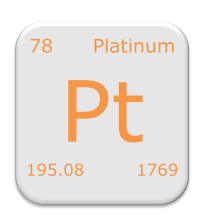
After the chemical separation of impurities in aqueous solution, metallic platinum is precipitated in the form of a powder or sponge with a purity of at least 99.95%. The purity is inspected by chemical analysis (e.g. ICP). However, as the maximum purity that can be determined by chemical analysis is about 99.99%. A further inspection process is needed if higher purity requirements have to be met.
The main properties used for this purpose are the electromotive force (EMF) and the temperature coefficient of electrical resistance (a). Platinum is considered to be physically pure when the EMF in contact with a platinum standard calibrated according to the International Temperature Scale of 1990 (ITS-90[i]) is equal to 0.
The precisely calibrated platinum of the highest purity yields a= 3.925 x 10-3 K-1 over the temperature range 0-100°C. For practical applications, a value of a= 3.850 x 10-3 K-1 is understood to be the criterion for physical purity. A fine adjustment of the EMF is possible, when required, by doping with trace elements.
[i] ITS-90: International Temperature Scale of 1990